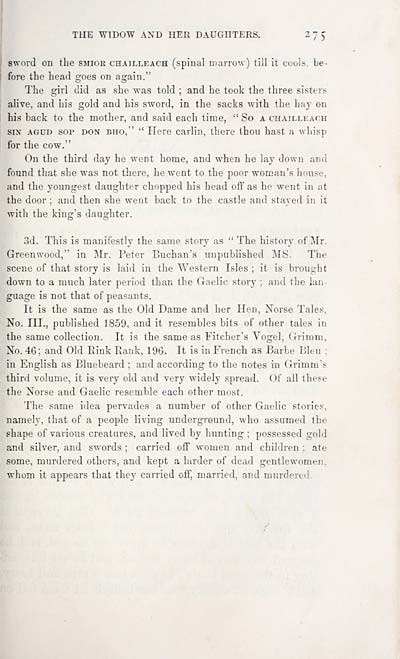Download files
Complete book:
Individual page:
Thumbnail gallery: Grid view | List view

THE WIDOW AND HER DAUGHTERS. 275
swnrd on the smior chailleach (spinal marrow) till it cools, be-
fore the head goes on again."
The girl did as she was told ; and he took the three sisters;
alive, and his gold and his sword, in the sacks with the hay on
his back to the mother, and said each time, " So a ciiAiLLEAfiH
SIX AGDD SOP DON BHo," " Here carlin, there thou hast a whisp
for the cow."
On the third day he went home, and when he lay down and
found that she was not there, he went to the poor woman's house,
and the youngest daughter chopped his head off as he went in at
the door ; and then she went back to the castle and stayed in it
with the king's daughter.
3d. This is manifestly the same story as " The history of Mr.
Greenwood," in Mr. Peter Buchan's unpublished MS. The
scene of that story is laid in the Western Isles ; it is brought
down to a much later period than the Gaelic story ; and the lan-
guage is not that of peasants.
It is the same as the Old Dame and her Hen, Norse Tales.
No. TIL, published 1859, and it resembles bits of other tales in
the same collection. It is the same as Fitcher's Vogel, Grimm,
No. 46; and Old Rink Eank, 196. It is in French as Barbe Bleu :
in English as Bluebeard ; and according to the notes in Gi-imm's
third volume, it is very old and very widely spread. Of all these
the Norse and Gaelic resemble each other most.
The same idea pervades a number of other Gaelic stories,
namely, that of a people living underground, who assumed the
shape of various creatures, and lived by hunting ; possessed gold
and silver, and swords ; carried off women and children ; ate
some, murdered others, and kept a larder of dead gentlewomen,
whom it appears that they carried off, married, and murdered.
swnrd on the smior chailleach (spinal marrow) till it cools, be-
fore the head goes on again."
The girl did as she was told ; and he took the three sisters;
alive, and his gold and his sword, in the sacks with the hay on
his back to the mother, and said each time, " So a ciiAiLLEAfiH
SIX AGDD SOP DON BHo," " Here carlin, there thou hast a whisp
for the cow."
On the third day he went home, and when he lay down and
found that she was not there, he went to the poor woman's house,
and the youngest daughter chopped his head off as he went in at
the door ; and then she went back to the castle and stayed in it
with the king's daughter.
3d. This is manifestly the same story as " The history of Mr.
Greenwood," in Mr. Peter Buchan's unpublished MS. The
scene of that story is laid in the Western Isles ; it is brought
down to a much later period than the Gaelic story ; and the lan-
guage is not that of peasants.
It is the same as the Old Dame and her Hen, Norse Tales.
No. TIL, published 1859, and it resembles bits of other tales in
the same collection. It is the same as Fitcher's Vogel, Grimm,
No. 46; and Old Rink Eank, 196. It is in French as Barbe Bleu :
in English as Bluebeard ; and according to the notes in Gi-imm's
third volume, it is very old and very widely spread. Of all these
the Norse and Gaelic resemble each other most.
The same idea pervades a number of other Gaelic stories,
namely, that of a people living underground, who assumed the
shape of various creatures, and lived by hunting ; possessed gold
and silver, and swords ; carried off women and children ; ate
some, murdered others, and kept a larder of dead gentlewomen,
whom it appears that they carried off, married, and murdered.
Set display mode to: Large image | Transcription
Images and transcriptions on this page, including medium image downloads, may be used under the Creative Commons Attribution 4.0 International Licence unless otherwise stated. ![]()
| Early Gaelic Book Collections > Blair Collection > Popular tales of the West Highlands > Volume 2 > (293) |
|---|
| Permanent URL | https://digital.nls.uk/81396989 |
|---|
| Description | Vol. II. |
|---|---|
| Shelfmark | Blair.174 |
| Attribution and copyright: |
|
| Description | Orally collected, with a translation by J.F. Campbell. |
|---|---|
| Shelfmark | Blair.173-176 |
| Additional NLS resources: | |
| Description | A selection of books from a collection of more than 500 titles, mostly on religious and literary topics. Also includes some material dealing with other Celtic languages and societies. Collection created towards the end of the 19th century by Lady Evelyn Stewart Murray. |
|---|
| Description | Selected items from five 'Special and Named Printed Collections'. Includes books in Gaelic and other Celtic languages, works about the Gaels, their languages, literature, culture and history. |
|---|

